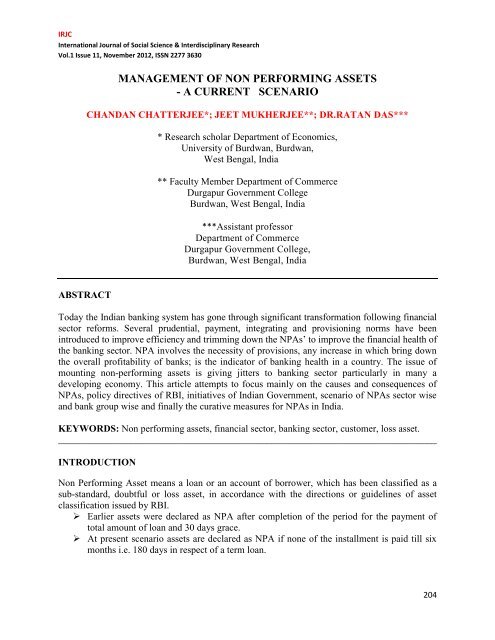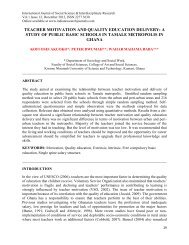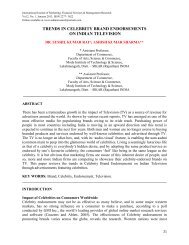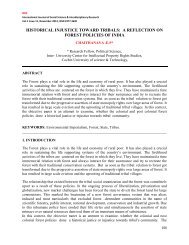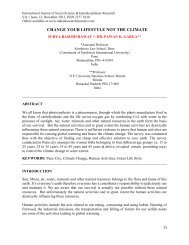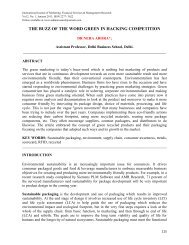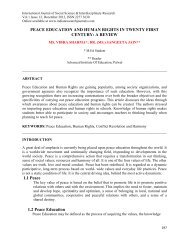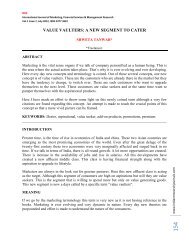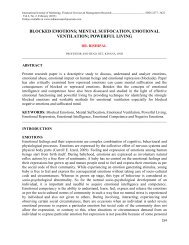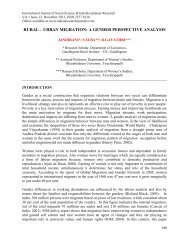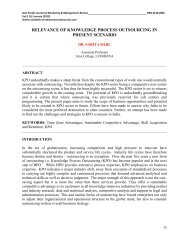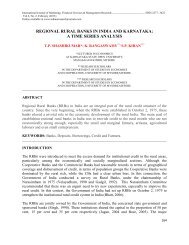management of non performing assets - a current scenario
management of non performing assets - a current scenario
management of non performing assets - a current scenario
Create successful ePaper yourself
Turn your PDF publications into a flip-book with our unique Google optimized e-Paper software.
IRJC<br />
International Journal <strong>of</strong> Social Science & Interdisciplinary Research<br />
Vol.1 Issue 11, November 2012, ISSN 2277 3630<br />
MANAGEMENT OF NON PERFORMING ASSETS<br />
- A CURRENT SCENARIO<br />
CHANDAN CHATTERJEE*; JEET MUKHERJEE**; DR.RATAN DAS***<br />
* Research scholar Department <strong>of</strong> Economics,<br />
University <strong>of</strong> Burdwan, Burdwan,<br />
West Bengal, India<br />
** Faculty Member Department <strong>of</strong> Commerce<br />
Durgapur Government College<br />
Burdwan, West Bengal, India<br />
***Assistant pr<strong>of</strong>essor<br />
Department <strong>of</strong> Commerce<br />
Durgapur Government College,<br />
Burdwan, West Bengal, India<br />
ABSTRACT<br />
Today the Indian banking system has gone through significant transformation following financial<br />
sector reforms. Several prudential, payment, integrating and provisioning norms have been<br />
introduced to improve efficiency and trimming down the NPAs‟ to improve the financial health <strong>of</strong><br />
the banking sector. NPA involves the necessity <strong>of</strong> provisions, any increase in which bring down<br />
the overall pr<strong>of</strong>itability <strong>of</strong> banks; is the indicator <strong>of</strong> banking health in a country. The issue <strong>of</strong><br />
mounting <strong>non</strong>-<strong>performing</strong> <strong>assets</strong> is giving jitters to banking sector particularly in many a<br />
developing economy. This article attempts to focus mainly on the causes and consequences <strong>of</strong><br />
NPAs, policy directives <strong>of</strong> RBI, initiatives <strong>of</strong> Indian Government, <strong>scenario</strong> <strong>of</strong> NPAs sector wise<br />
and bank group wise and finally the curative measures for NPAs in India.<br />
KEYWORDS: Non <strong>performing</strong> <strong>assets</strong>, financial sector, banking sector, customer, loss asset.<br />
______________________________________________________________________________<br />
INTRODUCTION<br />
Non Performing Asset means a loan or an account <strong>of</strong> borrower, which has been classified as a<br />
sub-standard, doubtful or loss asset, in accordance with the directions or guidelines <strong>of</strong> asset<br />
classification issued by RBI.<br />
‣ Earlier <strong>assets</strong> were declared as NPA after completion <strong>of</strong> the period for the payment <strong>of</strong><br />
total amount <strong>of</strong> loan and 30 days grace.<br />
‣ At present <strong>scenario</strong> <strong>assets</strong> are declared as NPA if <strong>non</strong>e <strong>of</strong> the installment is paid till six<br />
months i.e. 180 days in respect <strong>of</strong> a term loan.<br />
204
IRJC<br />
International Journal <strong>of</strong> Social Science & Interdisciplinary Research<br />
Vol.1 Issue 11, November 2012, ISSN 2277 3630<br />
‣ Interest and/ or installment <strong>of</strong> principal remains overdue for two harvest seasons but for<br />
a period not exceeding two half years in the case <strong>of</strong> an advance granted for agricultural<br />
purpose, and<br />
‣ Any amount to be received remains unpaid for a period <strong>of</strong> more than 90 days in respect<br />
<strong>of</strong> other accounts<br />
With effect from March 31, 2004, a <strong>non</strong>-<strong>performing</strong> asset (NPA) shall be a declared as a loan<br />
or an advance where;<br />
• Installment <strong>of</strong> principal or interest remain overdue for a period exceeding 90 days in<br />
respect <strong>of</strong> a Term Loan,<br />
• The account remains 'out <strong>of</strong> order' for a period <strong>of</strong> more than 90 days, relating to Cash<br />
Credit or Bank Overdraft<br />
• The bill remains unsettled for a period <strong>of</strong> more than 90 days in respect <strong>of</strong> a purchased or<br />
discounted bill.<br />
Types <strong>of</strong> NPA:<br />
There are three major types <strong>of</strong> NPA:<br />
• Sub-standard : The account holder belonging to this category don‟t pay three installment<br />
continuously after 90 days and up to 1year. Bank has made 10% provision <strong>of</strong> funds for<br />
this category to meet the losses generated from NPA from their pr<strong>of</strong>it.<br />
• Doubtful NPA : Doubtful NPA are classified into three sub categories :<br />
• 20% provision is made by the banks for D1 i.e. up to 1 year<br />
• 30% provision is made by the bank for D2 i.e. up to 2 year<br />
• 100% provision is made by the bank for D3 i.e. up to 3 year.<br />
• Loss Assets : When account holder belongs to this category 100% provision is made by<br />
the banks to write <strong>of</strong>f their accounts. After this the <strong>assets</strong> are delivered to recovery agents<br />
for the purpose <strong>of</strong> sale.<br />
Reasons behind NPA:<br />
Default <strong>of</strong> a loan intentionally<br />
Frequent shuffle <strong>of</strong> govt. policies leads to NPA.<br />
Customer has taken the loan for <strong>non</strong> performance <strong>of</strong> business<br />
Most <strong>of</strong> the loan sanctioned for agricultural purposes<br />
Negligent pre-enquiry by the bank for sanctioning the loan to a customer.<br />
Effects <strong>of</strong> NPA on banks & FI:<br />
Continuous draining <strong>of</strong> pr<strong>of</strong>it.<br />
Negative impact on goodwill.<br />
Adverse growth <strong>of</strong> equity value.<br />
Restricted cash flow by bank due to provision <strong>of</strong> fund created against NPA.<br />
Gross NPA and Net NPA:<br />
Gross NPA is advance which is considered irrecoverable, for whom the bank has made<br />
205
IRJC<br />
International Journal <strong>of</strong> Social Science & Interdisciplinary Research<br />
Vol.1 Issue 11, November 2012, ISSN 2277 3630<br />
provisions, and which is still held in banks' books <strong>of</strong> account. Net NPA is obtained by deducting<br />
items like interest due but not recovered, part payment received and other income kept in<br />
suspense account from Gross NPA.<br />
In India, when the loan is sanctioned against any security, provision has to be created. Further,<br />
Indian Banks have to make a100 per cent provision which is treated as a „doubtful‟advance,<br />
while in some countries; it is 50 per cent or just 75 per cent. According to the RBI, "Reduction <strong>of</strong><br />
NPAs in the Indian banking sector should be treated as a national priority item to make the<br />
system stronger, resilient and geared to meet the challenges <strong>of</strong> globalization. It is necessary that a<br />
public debate is started soon on the problem <strong>of</strong> NPAs and their resolution. "<br />
OBJECTIVES<br />
1) To understand the NPAs sector wise.<br />
2) To make a comparative study <strong>of</strong> NPA‟s <strong>of</strong> public sector banks, private sector banks and<br />
foreign sector banks.<br />
3) To understand the relationship between NPA‟s net pr<strong>of</strong>it and advances<br />
4) To understand the recovery <strong>of</strong> NPAs through various channels.<br />
METHODOLOGY<br />
The present study is aims to analyze the NPA‟s <strong>of</strong> Indian Banks. For the purpose <strong>of</strong> the study<br />
data has been collected from secondary sources. The main source <strong>of</strong> information has been<br />
through RBI reports and bulletins.<br />
CASE STUDY :AN ANALYTICAL DISCUSSION<br />
Here the Scheduled Commercial Bank is taken as a sample to analyze the <strong>management</strong> <strong>of</strong> Non<br />
Performing Assets. At first we will study the lending composition <strong>of</strong> SCBs by analyzing the<br />
three core sectors <strong>of</strong> economy i.e. priority sector, public sector and <strong>non</strong>-priority sector.<br />
Non Performing Assets Sector-wise:<br />
Bank mainly lends to three sectors i.e. priority sector, public sector and <strong>non</strong>-priority sector. The<br />
lending composition <strong>of</strong> the Indian Banks is studied from the Table No - 1<br />
Secondly the graphical analysis <strong>of</strong> the lending composition <strong>of</strong> scheduled commercial bank is<br />
shown in Figure - 1 and Figure - 2. The only reason behind these is to study the trend <strong>of</strong><br />
<strong>non</strong><strong>performing</strong> <strong>assets</strong> in scheduled commercial bank <strong>of</strong> India.<br />
Thirdly the tabular analysis <strong>of</strong> the Gross and Net NPAs <strong>of</strong> SCBs- Bank Group Wise is displayed<br />
in Table no-2 to study the percentage <strong>of</strong> Gross NPA and Net NPA to Gross and Net Advances<br />
respectively.<br />
Then the Graphical Analysis <strong>of</strong> respective Gross and Net NPAs <strong>of</strong> SCBs Bank Group wise is<br />
shown in Figure - 3 and Figure - 4 in order to assess the NPA <strong>management</strong> <strong>of</strong> SCB.<br />
206
IRJC<br />
International Journal <strong>of</strong> Social Science & Interdisciplinary Research<br />
Vol.1 Issue 11, November 2012, ISSN 2277 3630<br />
Finally the tabular analysis and graphical analysis <strong>of</strong> the data pertaining to the recovery <strong>of</strong> NPAs<br />
by SCBs through various channels is presented in order to restructure the banking system by<br />
reducing the level <strong>of</strong> NPA<br />
Table-1: Lending composition <strong>of</strong> Indian banks<br />
Sector<br />
Public sector<br />
2009-10 2010-11<br />
Old Private Sector<br />
2009-10 2010-11<br />
New Private Sector<br />
2009-10 2010-2011<br />
All SCB’s<br />
2009-10 2010-11<br />
A. Priority Sector 30848<br />
(53.8)<br />
i)Agriculture 8,330<br />
(14.5)<br />
Ii)Small scale industries 11,537<br />
(20.1)<br />
iii)Others 10,981<br />
(19.2)<br />
B. Public Sector 524<br />
(0.9)<br />
C .Non-Priority Sector 26,453<br />
(46.2)<br />
Total (A+B+C) 57,301<br />
(100)<br />
41245<br />
(58.1)<br />
14487<br />
(20.4)<br />
14.340<br />
(20.2)<br />
12,417<br />
(17.5)<br />
278<br />
(0.4)<br />
29,802<br />
(41.9)<br />
71,047<br />
(100)<br />
1613<br />
(44.7)<br />
269<br />
(7.4)<br />
475<br />
(13.2)<br />
869<br />
(24.1)<br />
-<br />
-<br />
1,999<br />
(55.3)<br />
3,612<br />
(100)<br />
1599<br />
(43.3)<br />
417<br />
(11.3)<br />
551<br />
(14.9)<br />
631<br />
(17.1)<br />
-<br />
-<br />
2,095<br />
(56.7)<br />
3,694<br />
(100)<br />
3179<br />
(23.1)<br />
1,754<br />
(12.7)<br />
664<br />
(4.8)<br />
760<br />
(5.5)<br />
-<br />
-<br />
10,594<br />
(76.9)<br />
13,773<br />
(100)<br />
3224<br />
(22.6)<br />
1,755<br />
(12.3)<br />
746<br />
(5.2)<br />
722<br />
(5.1)<br />
-<br />
-<br />
11,053<br />
(77.4)<br />
14.277<br />
(100)<br />
Amount in crores<br />
35640<br />
(47.7)<br />
46068<br />
(51.8)<br />
10,353 16,660<br />
(13.9) (18.7)<br />
12,676 15,638<br />
(17.0) (17.6)<br />
12,611 13,370<br />
(16.9) (15.5)<br />
524 431<br />
(0.7) (0.5)<br />
39,045 42,950<br />
(52.3) (48.2)<br />
74,685 89,017<br />
(100) (100)<br />
Fig-1: Graphical Composition <strong>of</strong> Scheduled Commercial Bank in 2010<br />
SCB's(2010)<br />
priority sector(2010)<br />
public sector(2010)<br />
Non Priority sector(2010)<br />
207
IRJC<br />
International Journal <strong>of</strong> Social Science & Interdisciplinary Research<br />
Vol.1 Issue 11, November 2012, ISSN 2277 3630<br />
Fig-2: Graphical Composition <strong>of</strong> Scheduled Commercial Bank<br />
SCB's(2011)<br />
Priority sector(2011)<br />
Public Sector(2011)<br />
Non Priority Sector(2011)<br />
Table-2: Gross and Net NPAs <strong>of</strong> SCBs- Bank Group Wise<br />
Bank Group Year Gross NPAs Net NPAs<br />
All SCBs<br />
2005<br />
2006<br />
2007<br />
2008<br />
2009<br />
2010<br />
2011<br />
% to Gross Advances % to Net Advances<br />
5.2<br />
1.9<br />
3.3<br />
1.2<br />
2.5<br />
1.0<br />
2.3<br />
1.0<br />
2.25<br />
1.05<br />
2.39<br />
1.12<br />
2.25<br />
0.97<br />
PSB<br />
2005<br />
2006<br />
2007<br />
2008<br />
2009<br />
2010<br />
2011<br />
5.5<br />
3.6<br />
2.7<br />
2.2<br />
1.97<br />
2.19<br />
2.23<br />
2.0<br />
1.3<br />
1.1<br />
1.0<br />
0.94<br />
1.09<br />
1.09<br />
Old Private Sector Banks<br />
2005<br />
2006<br />
2007<br />
2008<br />
2009<br />
2010<br />
2011<br />
6.0<br />
4.4<br />
3.1<br />
2.3<br />
2.36<br />
2.32<br />
1.97<br />
2.7<br />
1.7<br />
1.0<br />
0.7<br />
0.90<br />
0.78<br />
0.53<br />
New Private Sector Banks<br />
2005<br />
2006<br />
2007<br />
2008<br />
2009<br />
2010<br />
2011<br />
3.6<br />
1.7<br />
1.9<br />
2.5<br />
3.05<br />
2.87<br />
2.33<br />
1.9<br />
0.8<br />
1.0<br />
1.2<br />
1.40<br />
1.08<br />
0.56<br />
Foreign Banks in India<br />
2005<br />
2006<br />
2007<br />
2008<br />
2009<br />
2010<br />
2011<br />
2.8<br />
1.9<br />
1.8<br />
1.8<br />
3.80<br />
4.26<br />
2.54<br />
0.8<br />
0.8<br />
0.7<br />
0.8<br />
1.81<br />
1.82<br />
0.67<br />
208
IRJC<br />
International Journal <strong>of</strong> Social Science & Interdisciplinary Research<br />
Vol.1 Issue 11, November 2012, ISSN 2277 3630<br />
Fig-3: Gross NPA as a % to Gross Advances<br />
Fig-4: Net NPA as a % to Net Advances<br />
3<br />
2.5<br />
2<br />
1.5<br />
2005<br />
2006<br />
2007<br />
1<br />
2008<br />
0.5<br />
0<br />
All S C B s P S B O ld P rivate<br />
S ector B anks<br />
New P rivate<br />
S ector B anks<br />
F oreign<br />
B anks in<br />
India<br />
2009<br />
2010<br />
2011<br />
209
% <strong>of</strong> previous years G ros s<br />
NP A<br />
IRJC<br />
International Journal <strong>of</strong> Social Science & Interdisciplinary Research<br />
Vol.1 Issue 11, November 2012, ISSN 2277 3630<br />
Table-3: Amount recovered by SCBs through various channels<br />
(Amount in Rs crores)<br />
Recovery<br />
Channel<br />
2009-10 2010-11<br />
No <strong>of</strong><br />
cases<br />
referred<br />
Amount<br />
involved<br />
Amount<br />
recovered<br />
Col(4)<br />
as a %<br />
<strong>of</strong><br />
Col(3)<br />
No <strong>of</strong><br />
cases<br />
referred<br />
Amount<br />
involved<br />
Amount<br />
recovered<br />
(1) (2) (3) (4) (5) (6) (7) (8) (9)<br />
Col(8)<br />
as a %<br />
<strong>of</strong><br />
Col(7)<br />
i) Lok Adalats<br />
ii) DRTs<br />
iii)SARFAESI<br />
778833<br />
6019<br />
78366<br />
7235<br />
9797<br />
14249<br />
112<br />
3133<br />
4269<br />
1.55<br />
32.00<br />
30.00<br />
616018<br />
12872<br />
118642<br />
5254<br />
14092<br />
30604<br />
151<br />
3930<br />
11561<br />
2.87<br />
27.89<br />
37.78<br />
Total recovery<br />
channel<br />
863218<br />
31281<br />
7514<br />
24.02%<br />
747532<br />
49950<br />
15642<br />
31.31%<br />
Fig-5: Recovery rate <strong>of</strong> NPA<br />
NP A rec overed as a % <strong>of</strong> previous<br />
years G ros s NP A<br />
70<br />
65<br />
60<br />
55<br />
50<br />
NP A recovered as a %<br />
<strong>of</strong> previous years G ross<br />
NP A<br />
2008 2009 2010 2011<br />
55.6 66.1 56.5 56.8<br />
210
IRJC<br />
International Journal <strong>of</strong> Social Science & Interdisciplinary Research<br />
Vol.1 Issue 11, November 2012, ISSN 2277 3630<br />
ANALYSIS AND FINDINGS<br />
Table - 1 indicates that the share <strong>of</strong> NPAs in the priority sector to total NPAs <strong>of</strong> Public sector<br />
banks increased marginally to 58.1 percent in 2011 from 53.8 percent compared to that <strong>of</strong> 2010.<br />
However the share <strong>of</strong> NPAs <strong>of</strong> other sector and <strong>non</strong>-priority sector in respect <strong>of</strong> PSBs declined in<br />
2011 i.e. share <strong>of</strong> NPA <strong>of</strong> other sectors and <strong>non</strong>-priority sector in 2011 is declined to 17.5% and<br />
41.9% respectively. In case <strong>of</strong> NPAs <strong>of</strong> old and new private sector banks the rise and fall<br />
pertaining to the priority sector, public sector and <strong>non</strong>-priority sector is not a continuous<br />
phenome<strong>non</strong>. As for NPAs <strong>of</strong> public sector undertakings are concerned, on an aggregate it is<br />
found to be decreased from 0.7 percent in 2010 to 0.5 % in 2011. Similarly NPAs <strong>of</strong> the priority<br />
sector is found to be decreased from 52.3% to 48.2%.<br />
Graphically it is found from fig -1 and fig - 2, i.e. by studying two pie charts in 2010 and 2011, it<br />
is clearly evident that the NPA in 2010 has considerably decreased in 2011 mainly for the public<br />
sector and <strong>non</strong>-priority sector while the priority sector‟s NPA level has considerably increased.<br />
Table - 2 reveals that there is a significant improvement in NPAs recovery by studying all bank<br />
groups. It is observed that there is a sharp fall in Gross NPAs percent to Gross Advances is 5.2%<br />
in 2005 and it got decreased to 2.25 % in 2011 in case <strong>of</strong> SCBs. Similarly Net NPAs percent to<br />
Net Advances was 1.9 in 2005 and reduced to 0.97%.<br />
Graphically by studying fig 3 and fig 4, a sharp decrease in NPA level is observed not only in<br />
case <strong>of</strong> SCBs but also in case <strong>of</strong> PSBs, old private sector banks and foreign banks in India.<br />
However, still the decline rate in Gross NPAs is found to be sharper in the old private sector,<br />
public sector bank and in all the scheduled commercial bank. While in case <strong>of</strong> Net NPA, the<br />
decline rate is much more intense in the old private sector banks, new private sector, public<br />
sector banks and in all the scheduled commercial bank.<br />
Table No - 3 presents the data pertaining to the recovery <strong>of</strong> NPAs by SCBs through various<br />
channels like Lok Adalats, DRTs and SARFAESI act. All total recovery in 2011 is 31.31%<br />
which is higher than recovery rate i.e. 24.02% in 2010. Most <strong>of</strong> the NPA recovered in 2010<br />
through Debt-Recovery Tribunal (DRT), while that <strong>of</strong> 2011 is recovered through “The<br />
Securitization and Reconstruction <strong>of</strong> Financial Assets and Enforcement <strong>of</strong> Security Interest<br />
(SARFAESI) ordinance 2002”<br />
Figure-5 represents that most <strong>of</strong> the NPA recovered as a percentage <strong>of</strong> Gross NPA is in the year<br />
2009. Relative to the year 2008 and 2010 significant NPA is recovered in the year 2011 as a<br />
percentage <strong>of</strong> previous years Gross NPA which is 56.8%.<br />
CONCLUSIONS<br />
From the study it is quite evident that the NPAs have a negative influence on the achievement <strong>of</strong><br />
capital adequacy level, funds mobilization and deployment policy, banking system credibility,<br />
productivity and overall economy. On one hand, the Public Sector Banks which are the said to be<br />
a focal point <strong>of</strong> the Indian Banking system are in trouble with excessive governmental equity,<br />
211
IRJC<br />
International Journal <strong>of</strong> Social Science & Interdisciplinary Research<br />
Vol.1 Issue 11, November 2012, ISSN 2277 3630<br />
excessive NPAs and excessive manpower, while on the other hand the private sector banks are<br />
merging themselves through adoption <strong>of</strong> most up-to-date expertise and technological systems.<br />
Therefore considerable efforts are required at RBI, Ministry <strong>of</strong> Finance and all the banks level to<br />
control the menace <strong>of</strong> NPAs. The public sector banks should not be loaded with the<br />
doppelganger objectives <strong>of</strong> social welfare and pr<strong>of</strong>itability which seems to be mutually<br />
incongruent. While gross NPA reflects the quality <strong>of</strong> the loans made by banks, net NPA shows<br />
the actual burden <strong>of</strong> banks. The banks have to take a pivotal role to reduce NPAs in a time bound<br />
strategic approach. There has been an incessant decrease in the time period to declare a loan as<br />
<strong>non</strong>-<strong>performing</strong>. The continuous decrease in the time period is actually done to reduce gap<br />
between the International banking norms and Indian banking norms. This move will undoubtedly<br />
help to reduce the NPA level which in turn improves the asset quality <strong>of</strong> the banks. This <strong>scenario</strong><br />
will crave for a strong political will. When backed by the strong political and financial<br />
consciousness, Indian Banks will certainly able to find a satisfactory solution to the increasing<br />
problem <strong>of</strong> mounted NPAs.<br />
RECOMMENDATIONS<br />
Banks should find out the original reasons/purposes <strong>of</strong> the loan required by the borrower.<br />
Proper identification <strong>of</strong> the guarantor should be checked by the bank including scrutiny <strong>of</strong><br />
his/her wealth.<br />
Framing reasonably well documented loan policy and rules.<br />
Sound credit appraisal on well-settled banking norms with emphasis on reduction in Gross<br />
NPAs rather than Net NPAs<br />
Position <strong>of</strong> overdue accounts is reviewed on a weekly basis to arrest slippage <strong>of</strong> fresh account<br />
to NPA.<br />
Half yearly balance confirmation certificates should be obtained from the borrowers.<br />
A committee is constituted at Head Office, to review irregular accounts.<br />
Based on the recent trends, banks should emphasize more on priority sector for reducing the<br />
quantum <strong>of</strong> NPAs.<br />
Banks should ensure credibility <strong>of</strong> the borrower.<br />
Appropriate SWOT analysis should be done before disbursement <strong>of</strong> the advance.<br />
Banks should ensure that there is no diversion <strong>of</strong> funds disbursed to the borrower.<br />
Bank <strong>of</strong>ficials should frequently visit the unit and should assess the physical conditions <strong>of</strong> the<br />
<strong>assets</strong>, receivables and stocks therein.<br />
While advancing loans, the three principles <strong>of</strong> bank lending viz., Principle <strong>of</strong> Safety, Principle<br />
<strong>of</strong> Liquidity and principle <strong>of</strong> Pr<strong>of</strong>itability must be adhered to.<br />
Banks should get the Non Encumbrance and Valuation <strong>of</strong> the primary and collateral securities<br />
done.<br />
Banks should critically examine and analyze the reasons behind time overrun.<br />
The banks should ensure that latest technology is being used by the borrower, to avoid<br />
obsolescence.<br />
The banks should ensure that the <strong>assets</strong> are fully insured.<br />
Recovery competition system should be extended among the staff members. The recovering<br />
212
IRJC<br />
International Journal <strong>of</strong> Social Science & Interdisciplinary Research<br />
Vol.1 Issue 11, November 2012, ISSN 2277 3630<br />
highest amount should be felicitated.<br />
Adopting market intelligence for deciding the credibility <strong>of</strong> the borrowers<br />
Creation <strong>of</strong> a separate “Recovery Department” with Special Recovery Officer<br />
There surely is a need to distinguish between willful and <strong>non</strong> willful defaulters. In case <strong>of</strong> the<br />
latter category <strong>of</strong> defaulters, the law should not be as harsh as in case <strong>of</strong> former category.<br />
The recovery process is very slow; as such the Government needs to update the process which<br />
is fast and effective.<br />
Bank <strong>of</strong>ficers shouldn‟t forget the ethics <strong>of</strong> doing job.<br />
Last but not the least, the act(s) should be judiciously and selectively applied so that NPAs<br />
should be converted into <strong>performing</strong> <strong>assets</strong>.<br />
REFERENCES<br />
[1] Berger A. and De Young R. (1997) Journal <strong>of</strong> Banking & Finance, Vol. 21.<br />
[2] Bidani S.N. (2002) Managing Non Performing Assets in Banks, Vision Books, New Delhi.<br />
[3] Banking & Economy Update (2000) The Danger from NPAs is Real Enough.<br />
[4] IBA Bulletins.<br />
[5] Ms. Kanika Goyal, 2010. Empirical Study <strong>of</strong> Non Performing Assets Management <strong>of</strong> Indian<br />
Public Sector Banks, APJRBM Volume 1, Issue 1, October 2010.<br />
[6] Narayanan V. (2000) NPA Reduction- The New „Mantra <strong>of</strong> Slippage Management, IBA<br />
Bulletin.<br />
[7]Prashanth K Reddy (2002), “A comparative study <strong>of</strong> Non Performing Assets in India in the<br />
Global context - similarities and dissimilarities, remedial measures,”Oct, IIM Ahemadabad, India.<br />
[8] Pr<strong>of</strong>. G. V. Bhavani Prasad; D. Veena (2011), “NPAS in indian banking sector- trends and<br />
issues,”Volume 1, Issue 9.<br />
[9] Report on trend and progress <strong>of</strong> banking in India 2000-01 to 2010-11. Pdf.<br />
[10 Reserve Bank <strong>of</strong> India, Report on Trend and Progress <strong>of</strong> banking in India, Various issues,<br />
Bombay, India.<br />
213
IRJC<br />
International Journal <strong>of</strong> Social Science & Interdisciplinary Research<br />
Vol.1 Issue 11, November 2012, ISSN 2277 3630<br />
[11] Shalu rani(2011), “ a study on NPAs with Special reference to SCBs <strong>of</strong> India,RMS journal<br />
<strong>of</strong> <strong>management</strong> &IT,vol. 5,june,pp. 60 -68.<br />
[12] Singla, H. K. (2008): Financial Performance <strong>of</strong> Banks in India, the ICFAI Journal <strong>of</strong> Bank<br />
Management, 7 (1): 50-62.<br />
[13] Shivepuje C.R., Kaveri V.S. (1997) Management <strong>of</strong> Non-Performing Advances, Sultan<br />
Chand & Sons, New Delhi.<br />
[14] Sadhu Ranjit (2000) CRM IBA Bulletin.<br />
[15]The Economics Times.<br />
[16] www.rbi.org.in.<br />
[7] www.businessstandard.com.<br />
[8] www.economictimes.com.<br />
214


